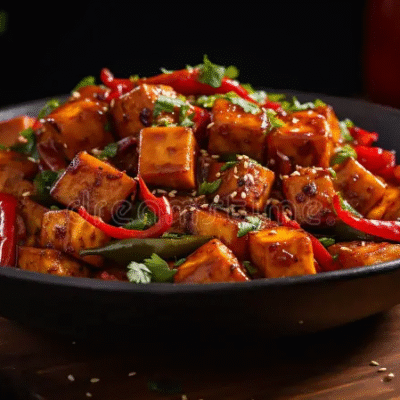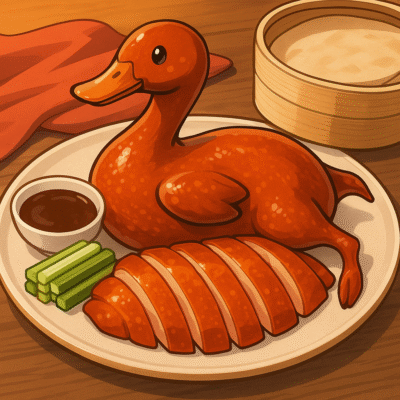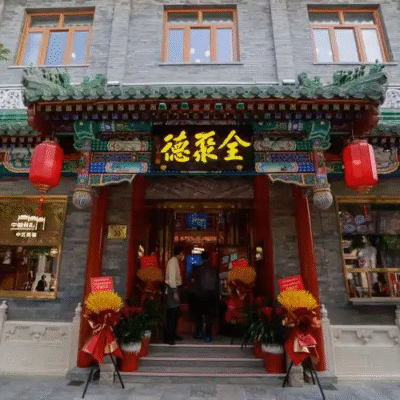If you travel to China but don’t taste Chinese cuisine, your trip will be full of regret. However, if the dishes you try are not representative of China’s authentic flavors, the regret will still remain. After all, each region offers a vast variety of foods, and it’s impossible to try every single dish among hundreds. Nevertheless, sampling these classic regional cuisines will definitely make your journey to China more complete and memorable.
The Eight Major Chinese Cuisines
China has a vast population and a wide territory. In earlier times, due to poverty, many regions faced shortages of ingredients or had foods that were difficult to eat. However, the hardworking and ingenious Chinese people always managed to transform these hard-to-eat or less accepted foods into uniquely flavorful and popular dishes through skillful cooking techniques. These foods not only solved survival challenges but also gradually became an integral part of China’s rich and diverse culinary culture, forming the daily diet of people across different regions.
Divided by region, China has eight major cuisines. Among these, our team has carefully selected several distinctive dishes based on the tastes of our foreign friends. In most cases, following our curated list will ensure a pleasant tasting experience without discomfort!
| Cuisine | Characteristics | Classic Dishes |
|---|---|---|
| Lu Cuisine (Shandong) | Fresh and salty taste, light flavor, focus on soup preparation | Sweet and sour carp, Braised chicken |
| Sichuan Cuisine (Chuan) | Numbing, spicy, sour, fragrant, strong flavors, often use Sichuan peppercorn and chili | Mapo tofu, Kung Pao chicken, Boiled fish in spicy sauce |
| Cantonese Cuisine (Yue) | Emphasizes original flavor of ingredients, light and fresh, commonly steamed, braised, or slow-cooked | Roast goose, Steamed sea bass, White-cut chicken |
| Jiangsu Cuisine (Su) | Focus on color, aroma, taste, and shape; tends to be slightly sweet and delicate | Squirrel mandarin fish, Braised crab meat meatballs, Yangzhou fried rice |
| Fujian Cuisine (Min) | Skilled in seafood, fresh and light taste, slightly sweet and sour | Buddha Jumps Over the Wall |
| Zhejiang Cuisine (Zhe) | Fresh and slightly sweet, good use of seafood, emphasis on color, aroma, and taste | West Lake vinegar fish, Dongpo pork |
| Hunan Cuisine (Xiang) | Mainly spicy and sour, strong flavors, unique seasoning | Steamed fish head with chopped chili, Kung Pao chicken, Stir-fried pork with chili |
| Anhui Cuisine (Hui) | Emphasizes precise control of heat, favors stewing and boiling, strong flavors | Stinky mandarin fish, Braised pork, Fermented tofu |
Lu Cuisine (Shandong Region), China
Lu Cuisine, also known as Shandong Cuisine, is one of the Eight Great Cuisines of China. It has a long history and is honored as the “Ancestor of All Cuisines,” reflecting profound cultural heritage and rich culinary traditions. Originating from Shandong Province, especially around the cities of Jinan and Qingdao, it is famous for its fresh and salty, yet light flavors, as well as its meticulous attention to the preparation of soups and sauces.
Among these, the most famous dishes include:
Sweet and Sour Carp
Sweet and Sour Carp is one of the classic representative dishes of Lu Cuisine and a traditional local specialty. Its history can be traced back to ancient China, especially in the Shandong region where carp is a common fish found in local rivers, making it an important ingredient in Lu Cuisine.
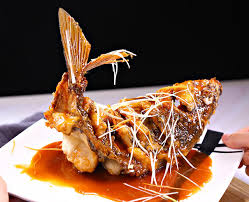
The combination of sweet and sour flavors reflects the unique taste preferences of the people of Shandong, especially in Lu cuisine, where the use of sweet and sour flavors is very common. The preparation of Sweet and Sour Carp not only showcases the culinary characteristics of Lu cuisine but also incorporates the wisdom and creativity of the local people.
If you decide to travel to China, the following restaurants are excellent choices to try this classic dish, Sweet and Sour Carp:
| Restaurant Name | City | Address |
|---|---|---|
| Baotu Spring Restaurant | Jinan | No. 1, Baotu Spring Street, Shizhong District, Jinan |
| Shandong Hotel | Jinan | No. 2, Wenhua West Road, Lixia District, near Quancheng Square, Jinan |
| Daguan Garden | Zibo | Southeast corner of Daguan Road & Linzi Road intersection, Zhangdian District, Zibo |
| Quanjude | Beijing | No. 14, Wangfujing Street, Dongcheng District, Beijing (Wangfujing & Dongdan Intersection) |
| Lu Xun Former Residence Restaurant | Shanghai | No. 155, Luxun Road, Huangpu District, near Shaoxing Road, Shanghai |
| White Swan Hotel | Guangzhou | No. 120, Xingang East Road, Haizhu District, near Zhujiang New Town, Guangzhou |
| Shandong Mansion Restaurant | Beijing | No. 12, Jianguomenwai Avenue, Chaoyang District, near Jianwai SOHO, Beijing |
| Lu Cuisine Restaurant | Shenyang | No. 100, Dabeijie Street, Heping District, near Shenyang Railway Station |
Braised Chicken
Another famous delicacy is Braised Chicken, specifically Dezhou Braised Chicken. It originates from Dezhou, Shandong Province, and has become a classic dish on Chinese dining tables due to its unique cooking technique and its rich, aromatic flavor.

Like Sweet and Sour Carp, Dezhou Braised Chicken also embodies the essence of Lu cuisine. It is especially loved by many diners for its crispy outside, tender inside, and perfect combination of color, aroma, and taste. If you want to try this delicious dish, the following restaurants offer excellent choices:
| Restaurant Name | City | Address |
|---|---|---|
| Dezhou Braised Chicken Old Shop | Dezhou | No. 12, Deshang Road, Decheng District, Dezhou, Shandong Province |
| Dezhou Braised Chicken King | Beijing | 1st Floor, Building B, East Area, Jianwai SOHO, Chaoyang District, Beijing (Branches nationwide) |
| Dezhou Braised Chicken Restaurant | Shanghai | No. 300, East Nanjing Road, near People’s Square, Huangpu District, Shanghai |
Lu cuisine not only represents Shandong’s rich historical and cultural heritage but also showcases the exquisite and unique traditional Chinese culinary techniques. If you want to taste Lu cuisine, these two dishes are must-orders at any restaurant. You don’t have to travel specifically to Shandong to enjoy them—in fact, you can find these delicacies in many second- and third-tier cities across China.
Chinese Sichuan Cuisine (Sichuan Region)
Sichuan cuisine, originating from Sichuan Province, is famous for its unique flavors characterized by numbness (mala), spiciness, sourness, and fragrance. It features rich layers of taste and a wide variety of seasonings, skillfully using chili peppers and Sichuan peppercorns to create a strong and exciting flavor impact. Sichuan cuisine holds an important place in both Chinese and global culinary cultures, and its distinctive characteristics are beloved by food lovers everywhere.
The following dishes are the most representative:
Mapo Tofu
Mapo Tofu, as one of the classic representatives of Sichuan cuisine, has indeed become one of the first dishes that come to mind for Japanese people when they think of Chinese cuisine.
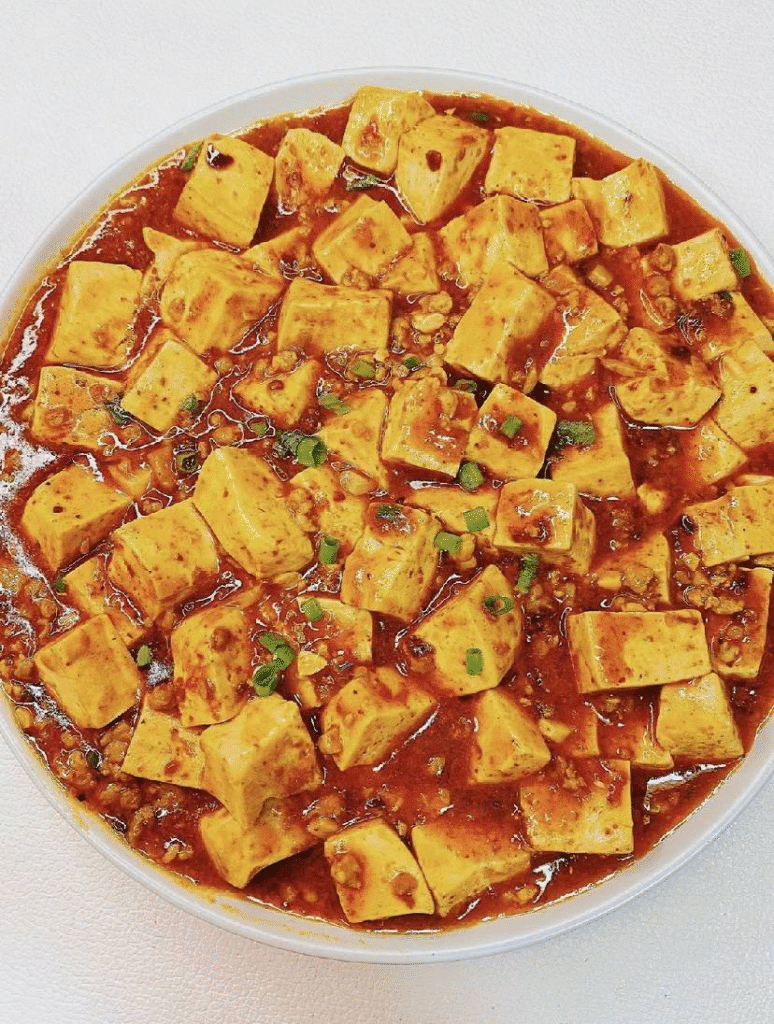
This dish, known for its unique combination of numbing spiciness and savory aroma, is extremely popular in Japanese restaurants and has almost become one of the iconic dishes representing Chinese cuisine.
Kung Pao Chicken
Kung Pao Chicken is a very famous dish in Sichuan cuisine, loved both in China and around the world for its unique flavor and delicious taste.
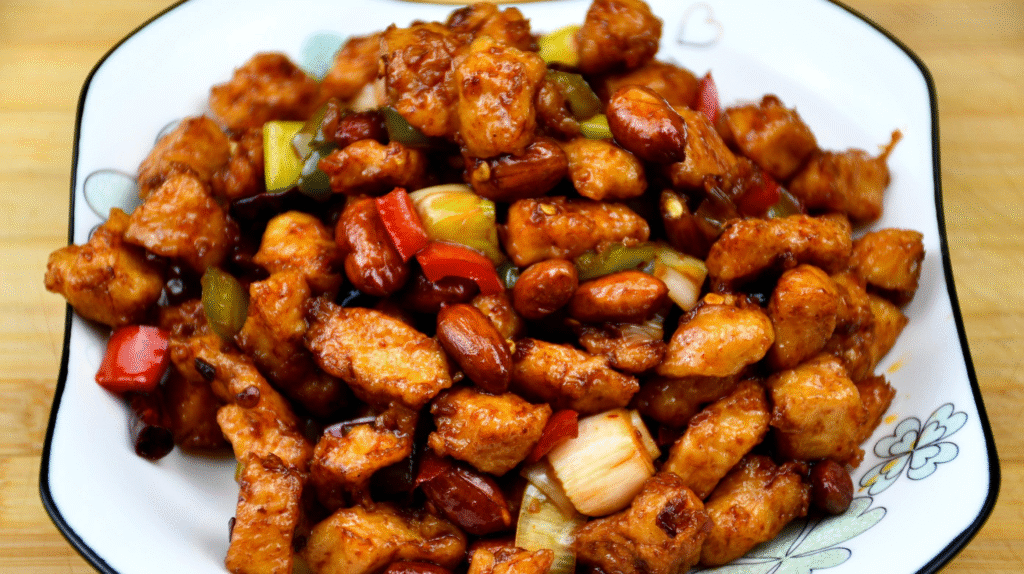
The name of this dish originates from Ding Baozhen, an official during the Qing Dynasty who served as a local governor in Sichuan. He was very fond of this chicken and peanut dish during his tenure, and thus the dish was named “Kung Pao Chicken” after his official title.
Boiled Fish in Spicy Sauce
Boiled Fish in Spicy Sauce is beloved for its tender fish fillets, numbing and spicy broth, and rich combination of spices. This dish cooks the fish slices thoroughly and enhances them with a strong mala flavor by using spicy seasonings and pouring hot oil over the top, making it one of the iconic dishes of Sichuan cuisine.
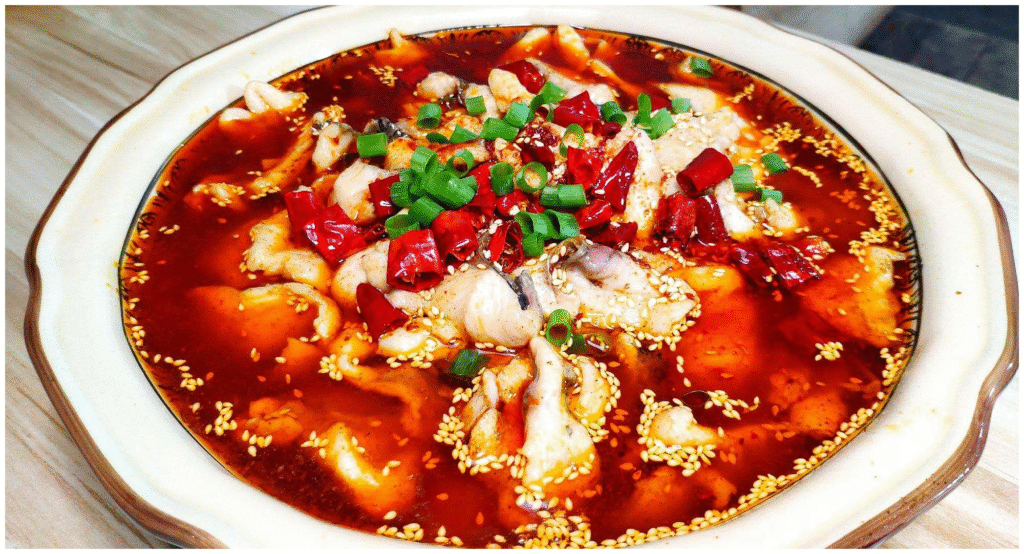
Cantonese Cuisine (Guangdong Cuisine)
Cantonese cuisine, originating from Guangdong Province, is known for its freshness, tenderness, lightness, and preserving the original flavors of ingredients. It places great emphasis on retaining the natural taste of food through balanced seasoning, resulting in dishes that are light yet flavorful. Cantonese cuisine highly values the freshness of ingredients, typically using seasonal produce in cooking. It is loved by diners both in China and abroad.
Roast Goose
Roast Goose is one of the classic and famous dishes in Cantonese cuisine, beloved for its crispy, fragrant skin and tender, juicy meat. It is an indispensable dish on Cantonese dining tables and a representative delicacy of Guangzhou, Hong Kong, and surrounding areas.
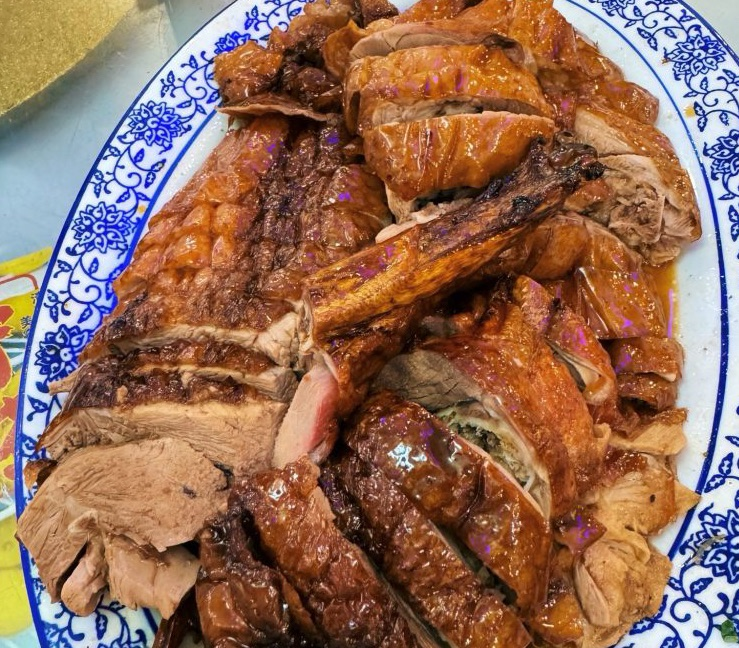
Roast Goose Preparation Process:
The process of making roast goose is relatively complex. It begins with selecting a high-quality goose — one with tender meat and a well-balanced ratio of fat to lean. The goose is then seasoned; traditionally, a specially formulated sauce is used for marination. This marination process usually lasts for several hours or more to ensure the flavor penetrates deep into the meat.
Next comes the roasting stage. Before roasting, special attention is paid to the treatment of the goose skin. Typically, a layer of syrup is brushed onto the skin, which helps create a crispier texture after roasting. Mastery of heat control is crucial during roasting — the goal is to achieve a crispy and delicate outer skin while keeping the meat tender and juicy. The goose is turned multiple times to ensure even cooking throughout.
Jiangsu Cuisine (Su Cuisine)
Su Cuisine, also known as Jiangsu cuisine, originates from Jiangsu Province and is characterized by its refinement, delicacy, and fresh, light flavors. It emphasizes the perfect harmony of color, aroma, taste, and presentation. Influenced deeply by history and culture, Su Cuisine pays great attention to the combination of ingredients and cooking techniques, with a strong artistic flair in how dishes are prepared and presented. Compared to other regional cuisines, it focuses more on layered textures and subtle flavoring.
Stewed Crab Roe Lion’s Head
“Lion’s Head” is a traditional signature dish of Jiangsu cuisine. The preparation involves finely mincing pork into a paste, then mixing it with crab roe and other seasonings to form large meatballs. These are gently stewed in a clear broth, resulting in a dish with rich flavor and a light, delicate soup.

The Lion’s Head meatball has a plump appearance, and with one bite, you’ll find the meat tender, soft, and incredibly juicy.
Fujian Cuisine (Min Cuisine)
Min Cuisine, also known as Fujian cuisine, originates from Fujian Province and boasts a long history and distinctive flavor profile. Known for its fresh and light taste, Min Cuisine especially excels in the use of seafood. It leans toward sweet and sour flavors and places great emphasis on the pairing of soups and sauces. The cooking techniques are refined, and the dishes often highlight the natural taste of the ingredients.
Buddha Jumps Over the Wall
“Buddha Jumps Over the Wall” is one of the most iconic dishes in Fujian cuisine. Celebrated for its complex preparation, rich variety of ingredients, and deeply flavorful broth, it is regarded as one of the finest delicacies among the Eight Great Cuisines of China.
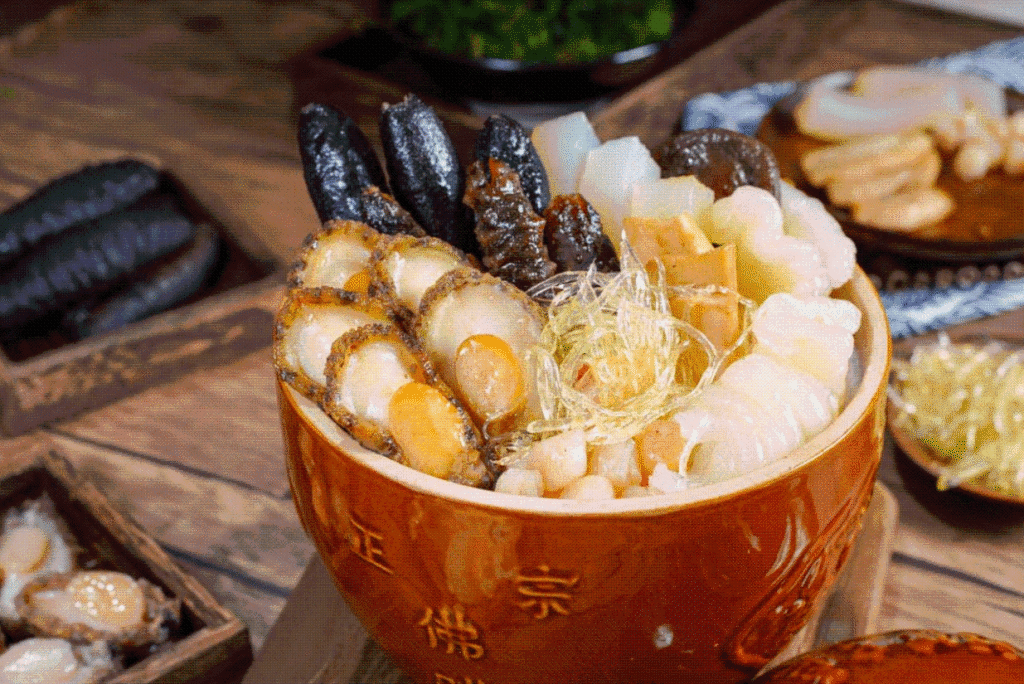
The name “Buddha Jumps Over the Wall” carries a legendary charm. According to folklore, its irresistible aroma was so enchanting that even monks meditating before a Buddha statue were tempted to leap over the temple walls just to taste it—hence the name.
Zhejiang Cuisine (Zhe Cuisine)
Originating from Zhejiang Province, Zhejiang cuisine is known for its diverse styles and long-standing history. It features a light, fresh, and slightly sweet taste, with a strong emphasis on seafood and freshwater ingredients. The cuisine values a harmonious balance of color, aroma, and flavor, with refined cooking techniques that highlight the natural essence of each ingredient. Overall, Zhejiang dishes offer a refreshing taste that is elegant and never greasy, representing the culinary beauty of the Jiangnan water towns.
West Lake Vinegar Fish
West Lake Vinegar Fish, also known as “Sister Song’s Fish Soup,” is a traditional and iconic dish from Hangzhou, Zhejiang. It is a standout of Zhejiang cuisine, renowned for its tender fish and its signature sweet-and-sour flavor.
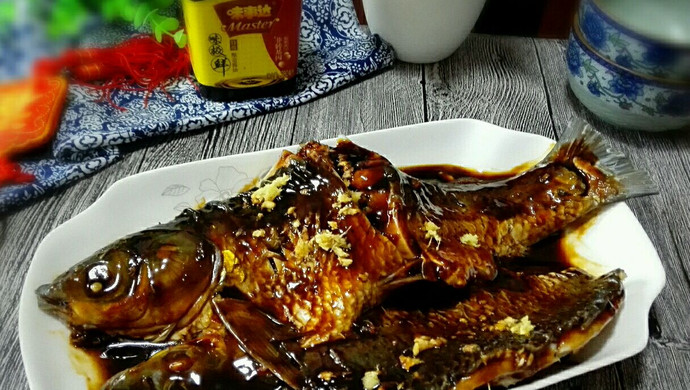
This dish typically uses fresh grass carp or common carp as the main ingredient and is steamed to preserve the fish’s natural flavor. Once cooked, it is topped with a sweet and sour sauce made primarily of vinegar, sugar, and soy sauce, resulting in a glossy red appearance and a uniquely tangy-sweet taste.
Key features include:
- Delicate, tender fish that melts in your mouth
- A perfect balance of sweet and sour, with no greasiness or fishy odor
- Fragrant, flavorful sauce that leaves a lasting impression
This dish not only reflects the light, elegant style of Zhejiang cuisine but also embodies the rich cultural heritage of Hangzhou. It is considered a must-try classic for anyone visiting the city.
Dongpo Pork
Dongpo Pork is named after the famous Song Dynasty poet Su Dongpo and is widely popular throughout the Jiangnan region. The dish is made using pork belly as the main ingredient. It undergoes several steps including blanching, slow simmering over low heat, and braising with soy sauce. The final result is a dish with a rich, glossy red color, a tender texture that holds its shape, and a taste that is rich but not greasy.
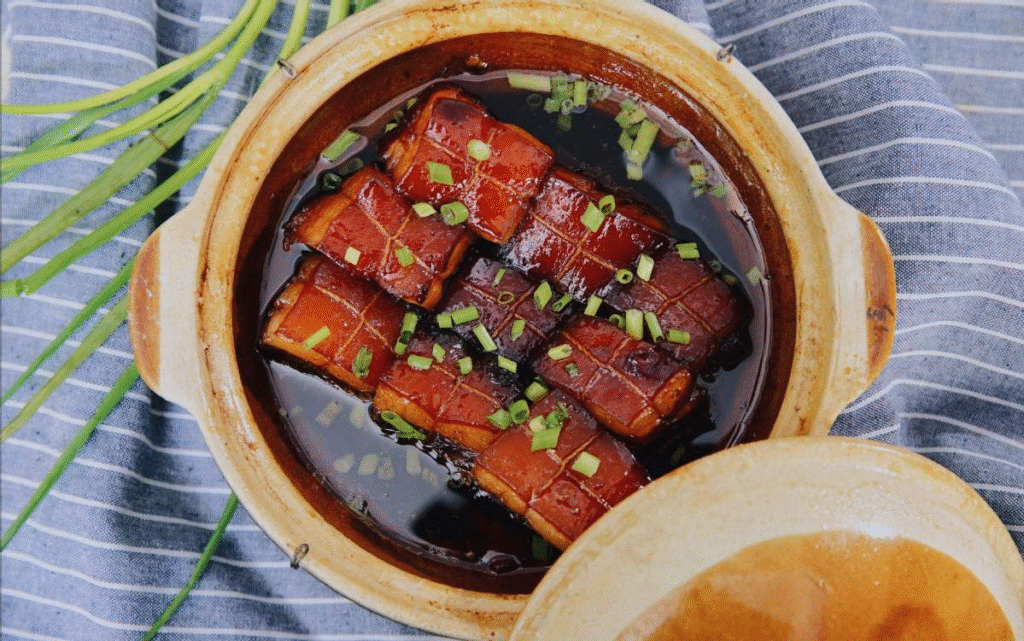
Dongpo Pork emphasizes the balance between heat control and seasoning. It melts in the mouth and leaves a lingering aroma, perfectly embodying the Zhejiang culinary philosophy of “moderation in richness, light but never bland.” More than just a classic dish, it symbolizes the fusion of poetic elegance and the warmth of everyday life.
Hunan Cuisine (Xiang Cuisine)
Originating from the Hunan region, Xiang Cuisine is one of the Eight Great Cuisines of China, known for its bold, spicy, and tangy flavors. Renowned for its rich and layered seasoning, Hunan cuisine frequently uses ingredients like chili peppers, Sichuan peppercorns, preserved meats, and chopped pickled chilies. Dishes are often prepared using methods such as stir-frying and braising, delivering a dynamic combination of aroma, heat, and sourness — a style with strong regional character and unmistakable identity.
Steamed Fish Head with Chopped Chili
Steamed Fish Head with Chopped Chili is a signature dish of Hunan cuisine, beloved for its vibrant color and spicy, savory flavor. It typically features the head of a fresh bighead carp (huālián yú) and is steamed with Hunan’s famous chopped pickled chili. The result is a dish bursting with intense heat and fragrance, with tender, delicate meat that melts in the mouth.
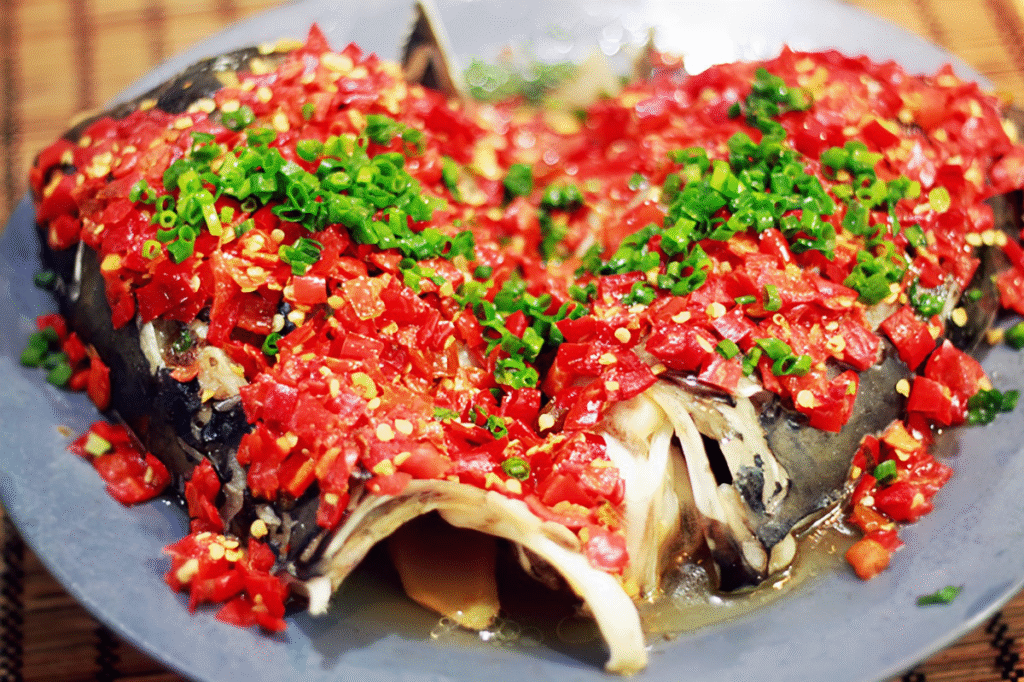
This dish not only highlights Hunan cuisine’s signature bold flavors and layered seasonings but also combines the freshness of steaming with the vibrant zest of chili peppers. The bright red chopped chilies covering the pristine white fish create a striking visual and flavorful impact, earning it the title of the “appetizer king” at the dining table.
Kung Pao Chicken
Kung Pao Chicken is a well-known classic dish originating from Sichuan during the Qing Dynasty. It is beloved by diners across China and around the world. The main ingredients include diced chicken, peanuts, and dried chili peppers, all stir-fried together with a specially crafted sauce. The dish is characterized by its bright red color and rich, aromatic flavor.
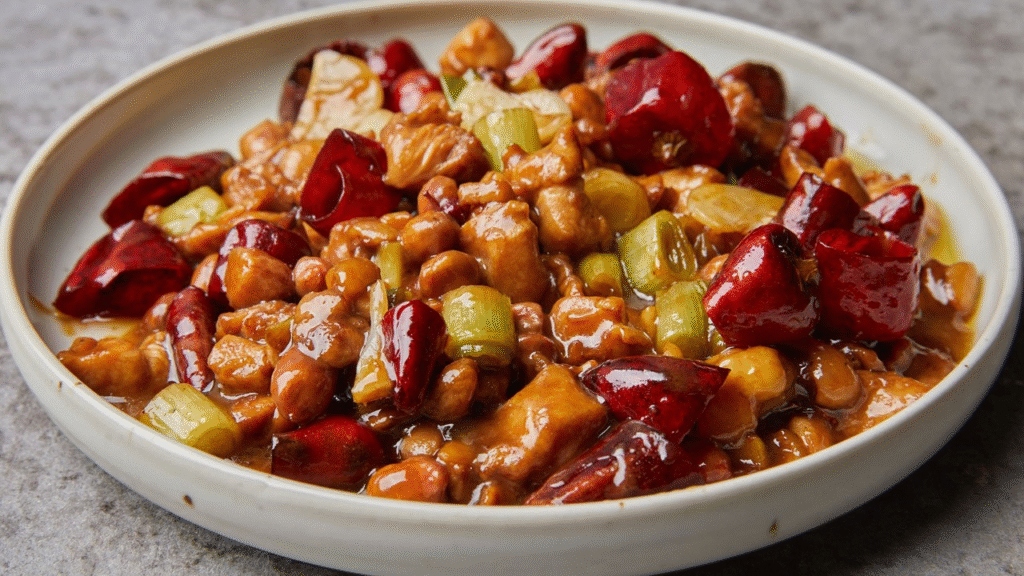
This dish is renowned for its crispy exterior and tender interior, featuring a sweet, sour, and mildly spicy flavor. It combines the signature numbing spiciness of Sichuan cuisine with a harmonious blend of northern and southern Chinese tastes. The rich, savory sauce is layered with a delightful crunch, making it both regionally distinctive and widely appealing. It stands as a timeless classic in Chinese culinary tradition.
Stir-Fried Pork with Chili Peppers
Stir-Fried Pork with Chili Peppers is one of the most iconic home-style dishes on Hunan dining tables and a classic that best captures the essence of “spicy” and “aromatic” in Xiang cuisine. It features fresh green chili peppers quickly stir-fried with pork belly or lean meat, seasoned simply with garlic, soy sauce, and other basic ingredients, yet it produces a bold and irresistible fragrance.
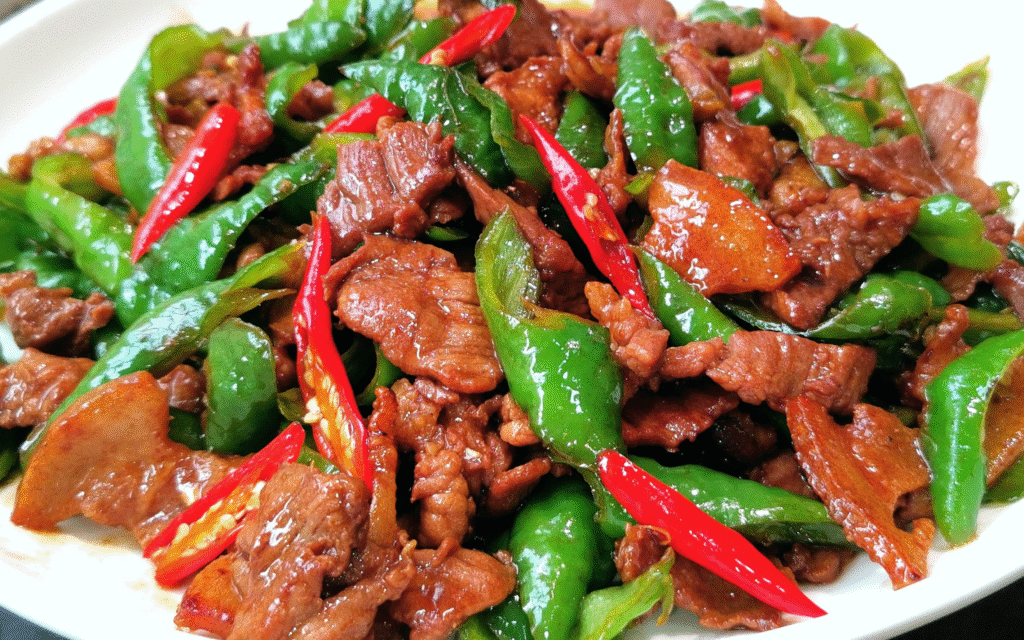
This dish has a glossy, appetizing appearance, with a rich aroma of meat and a robust spicy flavor that is hot but not overpowering. It is fresh, fragrant, and pleasantly flavorful. Though it appears simple, the cooking requires precise control of heat to achieve a full-bodied taste. It is one of the flavors that most vividly evokes a sense of nostalgia for Hunan natives.
Anhui Cuisine (Hui Cuisine)
Originating from Anhui Province, Hui Cuisine is a traditional culinary style known for its emphasis on ancient cooking methods and precise heat control. It favors slow-cooking techniques such as stewing, simmering, and braising, which bring out rich, mellow flavors and hearty, flavorful broths. The cuisine highlights authentic, seasonal ingredients and combines rustic mountain flavors with traditional craftsmanship. Overall, Hui Cuisine offers a robust yet elegant taste experience, reflecting the deep, unpretentious cultural heritage of the region.
Stinky Mandarin Fish
Stinky Mandarin Fish, also known as “Salted Fresh Mandarin Fish,” is a signature dish of Anhui cuisine. It is famous for its strong odor on the outside but fragrant and tender meat on the inside. The dish uses live mandarin fish that are briefly marinated to develop a distinctive aroma. The fish is then pan-fried in hot oil and slowly braised over low heat. The finished dish features a crispy skin, delicate flesh, and a rich, savory sauce.
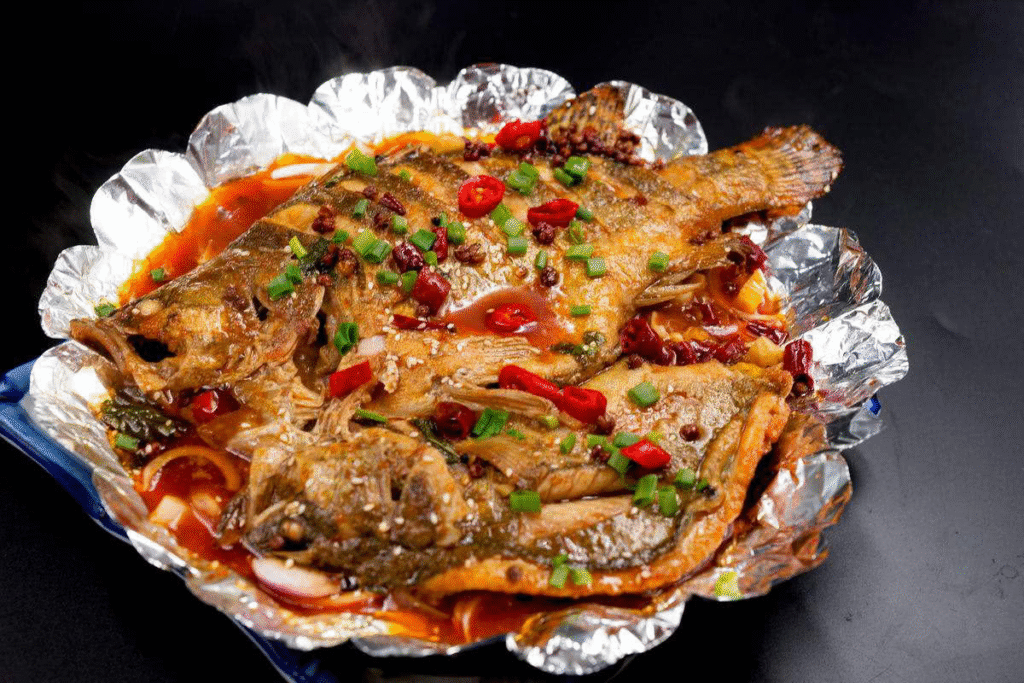
Though it is called “stinky,” the dish actually boasts a rich and fragrant aroma without any fishy taste, exemplifying the saying “strong in smell, irresistible in flavor.” It not only requires precise control of heat and skillful technique but also reflects Hui cuisine’s bold use of ingredients and intense flavor seasoning. This makes it one of the most iconic dishes embodying the authentic spirit of Anhui’s culinary tradition.
Braised Pork Belly (Hong Shao Rou)
Braised Pork Belly is a traditional and widely beloved dish across China, and it holds a special place as a classic in Anhui cuisine. Made primarily with pork belly, it is slowly simmered over low heat with soy sauce, sugar, cooking wine, and other seasonings. The result is a dish with a glossy red color, rich flavor, tender texture, and a perfect balance of fat that is flavorful yet not greasy.
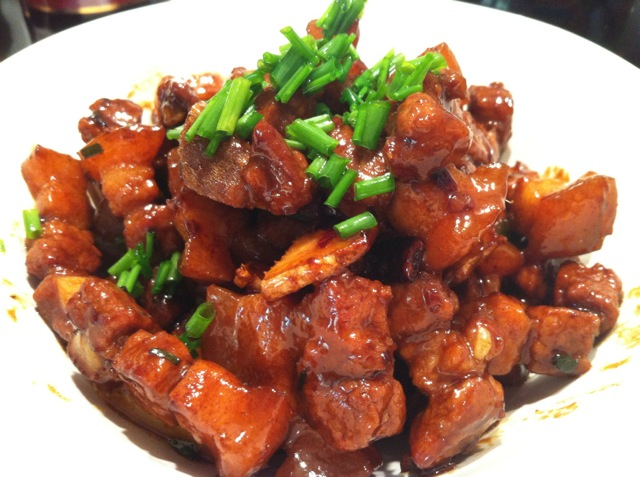
Hui-style Braised Pork Belly emphasizes slow simmering over low heat to allow the flavors to deeply develop and the original taste to settle. The meat becomes tender and gelatinous, rich with savory aroma. Every bite is warm and hearty, symbolizing both home cooking and nostalgic memories. More than just a flavorful dish, it is a timeless classic that carries the essence of human connection and cherished traditions.
Mao Tofu (Fermented Tofu)
Mao Tofu is a distinctive snack in Anhui cuisine, famous for its unique fermentation process and strong flavor. Made from fresh tofu, it undergoes natural fermentation during which a fine layer of “fur” forms on its surface. The tofu is then deep-fried or pan-fried until crispy on the outside and tender on the inside, releasing a special and distinctive aroma.

Mao Tofu has a distinctive appearance and a rich texture, featuring a subtle moldy aroma combined with savory soy sauce notes. Its flavor is strong yet not overpowering, making it an important representation of traditional rural Anhui culinary culture. Loved by locals, it carries a deep regional character and cultural significance.
In conclusion,
Chinese culinary culture is vast, profound, and wonderfully diverse. While it’s impossible to taste every delicacy, sampling the signature dishes from these classic regional cuisines offers a deep appreciation of China’s rich food heritage and charm. May your journey of flavors add unforgettable joy and satisfaction to your trip through China, letting delicious food become one of your most treasured memories along the way.

